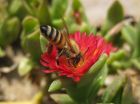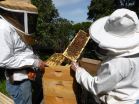INFORMATION:
Other authors on the paper include Peter Teal, research leader, U.S. Department of Agriculture, and James Frazier, professor emeritus, Penn State.
The USDA --Agriculture and Food Research Initiative funded this research.
Diet affects pesticide resistance in honey bees
2014-11-03
(Press-News.org) Feeding honey bees a natural diet of pollen makes them significantly more resistant to pesticides than feeding them an artificial diet, according to a team of researchers, who also found that pesticide exposure causes changes in expression of genes that are sensitive to diet and nutrition.
"Honey bees are exposed to hundreds of pesticides, while they are foraging on flowers and also when beekeepers apply chemicals to control bee pests," said Christina Grozinger, professor of entomology and director of the Center for Pollinator Research, Penn State. "Our study demonstrates that exposure to non-lethal doses of at least two of these pesticides causes large changes in the expression of genes involved in detoxification, immunity and nutrition-sensing. This is consistent with results from previous studies that have found that pesticide exposure compromises bees' immune systems. Furthermore, our study reveals a strong link, at the molecular level, between nutrition, diet and pesticide exposure."
Exploring this link further, the researchers found that diet significantly impacts how long bees can survive when given lethal doses of a pesticide.
"This interaction between pesticide exposure and nutrition is likely what's at play in our finding that feeding bees a complex diet of pollen -- their natural diet -- makes them significantly more resistant to lethal doses of a pesticide than feeding them a more simple, artificial diet," said Daniel Schmehl, postdoctoral researcher, University of Florida.
To determine the impact of pesticide exposure on gene expression patterns in honey bees, the scientists first fed one of two miticides -- coumaphos or fluvalinate, the two most abundant and frequently detected pesticides in the hive -- to bees for a period of seven days. On the seventh day, the researchers extracted RNA from the bees, attached a fluorescent marker to the RNA and examined differences in gene expression patterns -- indicated by changes in patterns of fluorescence -- between the pesticide-treated bees and the control bees.
"We found significant changes in 1,118 transcripts -- or pieces of RNA -- among the bees that were fed either of the two miticides compared to the control group," said Schmehl. "These transcripts included genes involved in detoxification, immunity and nutrition."
Based upon the results, the team performed several subsequent analyses aimed at understanding the impact of pesticides on honey bee physiology. One of these subsequent analyses examined the susceptibility of bees to pesticide stress after consuming a pollen diet or an artificial diet -- either a soy protein or no protein diet. The team fed the bees these diets while simultaneously feeding them a lethal dose of the pesticide chlorpyrifos, an insecticide that is frequently used to control pests in agricultural crops and commonly detected in honey bee hives. They then recorded bee mortality daily for each of the treatment groups for a period of 16 days.
The researchers found that the bees that were fed a pollen-based diet exhibited reduced sensitivity to chlorpyrifos compared to the bees that were fed an artificial diet.
The results appear in the online issue of the Journal of Insect Physiology.
"This is the first time such a strong link between pesticide exposure and diet has been demonstrated at the molecular level, and the first time the effects of artificial versus natural diets have been explored in terms of resistance to pesticides," said Grozinger. "Diet and nutrition can greatly impact the ability of bees to resist pesticides, and likely other stressors. However, agriculture and urbanization have reduced the amounts and diversity of flowering plants available to bees, which likely nutritionally stresses them and makes them more sensitive to these other stressors. If we can figure out which diets and which flowering plants are nutritionally optimal for honey bees, we can help bees help themselves."
ELSE PRESS RELEASES FROM THIS DATE:
Countries with poor marine safety records linked to oil spill vessels
2014-11-03
More than half of ships involved in the 100 largest oil spills of the past three decades were registered in states that consistently fail to comply with international safety and environmental standards, UBC researchers have determined.
The research also found one-third of the current global oil tanker fleet are flying the flags of states with poor marine safety records—what they term "flags of non-compliance."
"Vessels flying flags of non-compliance create more problems than the rest of the global fleet," observes Rashid Sumaila, co-author of the study and director ...
Study: Maple syrup production declines after big seed year
2014-11-03
For decades, maple syrup producers have eyed the weather to help understand spring sugar yields. But new research in the journal Forest Ecology and Management reveals a more valuable metric for understanding – and even predicting – syrup production: how many seed helicopters rained down from the trees the year before?
"Weather affects how much sap will flow out of the tree, but sap volume is only one piece of the puzzle," says Josh Rapp, who as a postdoctoral fellow with Elizabeth Crone, associate professor of biology at Tufts University and senior author ...
What is a species? It could be difficult to reply if you work with aphids
2014-11-03
Karyotype is usually a stable feature of each species since chromosomal changes, if they occur, may contribute to the formation of barriers between populations causing the establishment of reproductive isolation and speciation as possible consequences. Indeed, mating between individuals with different karyotypes frequently produces hybrids with a reduced fertility (or sterile) due to mis-segregation of chromosomes during meiosis.
Despite the occurrence of this general rule, it seems that some animal species failed their examination in genetics and adopt different rules. ...
New process transforms wood, crop waste into valuable chemicals
2014-11-03
MADISON, Wis. – Scientists today disclosed a new method to convert lignin, a biomass waste product, into simple chemicals. The innovation is an important step toward replacing petroleum-based fuels and chemicals with biorenewable materials, says Shannon Stahl, an expert in "green chemistry" at the University of Wisconsin-Madison.
Lignin is the substance that makes trees and cornstalks sturdy, and it accounts for nearly 30 percent of the organic carbon in the biosphere. Stahl, senior author of a new report in the journal Nature, notes that lignin is a waste product ...
Same pieces, different picture
2014-11-03
Scientists at the European Molecular Biology Laboratory (EMBL) in Heidelberg, Germany and collaborators from Heidelberg University, in the joint Molecular Medicine Partnership Unit, have obtained the first structure of the immature form of HIV at a high enough resolution to pinpoint exactly where each building block sits in the virus. The study, published online today in Nature, reveals that the building blocks of the immature form of HIV are arranged in a surprising way.
"The structure is definitely different from what we'd expected," says John Briggs from EMBL, who led ...
Research partnership is key to biodiversity conservation
2014-11-03
A new policy paper led by University of York scientists, in partnership with Proforest, aims to increase awareness among researchers of the High Conservation Value (HCV) approach to safeguarding ecosystems and species.
The HCV approach is widely used in sustainable land management schemes to identify important ecosystems and species to conserve, but is little known in academia and the scientific evidence base is lacking.
The policy paper encourages new research into the effectiveness of the HCV process and greater knowledge exchange between scientists, HCV users and ...
New classification improves risk prediction in chronic lymphocytic leukemia
2014-11-03
If chronic lymphocytic leukemia patients with a good or poor prognosis could be identified already at the time of diagnosis, physicians would have better possibilities to adjust their therapeutic and follow-up strategies. Now researchers at Uppsala University, together with international colleagues, have discovered a new correlation between specific molecular features of the disease and subgroups of patients with different prognosis.
The results have been published in the journal Lancet Haematology.
Chronic lymphocytic leukemia (CLL) is an incurable tumour disease ...
MRSA bugs linked to livestock are found in hospitals, study finds
2014-11-03
Some MRSA bugs in UK hospitals can be traced back to a type of bacteria found in farm animals, a study suggests.
A strain of drug-resistant bacteria carried by some livestock – the MRSA strain Staphylococcus aureus CC398 – has also been found in patients, researchers say.
People and animals generally harbour distinct variants of CC398, which the team say evolved from the same original bacteria. However, the CC398 strain found in livestock can be transmitted to humans, and the study shows that this has happened on many occasions.
The study provides new ...
VLTI detects exozodiacal light
2014-11-03
Using the Very Large Telescope Interferometer (VLTI) in near-infrared light [1], the team of astronomers observed 92 nearby stars to probe exozodiacal light from hot dust close to their habitable zones and combined the new data with earlier observations [2]. Bright exozodiacal light, created by the glowing grains of hot exozodiacal dust, or the reflection of starlight off these grains, was observed around nine of the targeted stars.
From dark clear sites on Earth, zodiacal light looks like a faint diffuse white glow seen in the night sky after the end of twilight, or ...
Preterm, low birth-weight babies may need new hips in adulthood
2014-11-03
Researchers from Australia report that low birth weight and preterm birth are linked to increased risk for osteoarthritis (OA)-related hip replacements in adulthood. Findings published in the American College of Rheumatology (ACR) journal, Arthritis Care & Research, indicate that low birth weight and pre-term babies were not at greater risk of knee arthroplasty due to OA as adults.
According to the ACR, 27 million Americans over the age of 25 are diagnosed with clinical OA. Symptoms of OA range from mild to severe and include pain, stiffness, and swelling of joints. ...




